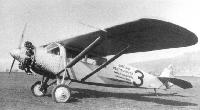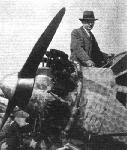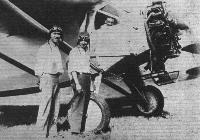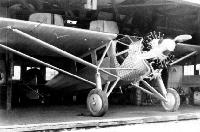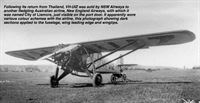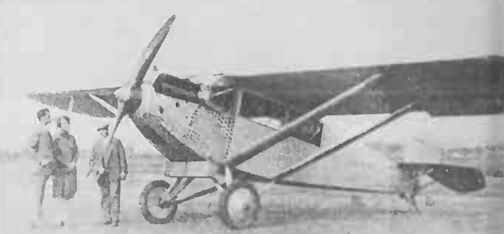
Описание
Страна : США
Год : 1927
Пятиместный транспортный самолет с закрытой кабиной
Ryan. Ранние самолеты
<...>
Успешная эксплуатация M-1 и M-2 позволила разработать самолет B.1 Brougham. Прототип B.1 был оснащен рядным ПД Hispano-Suiza, но на серийные машины устанавливался радиальный ПД Wright J-5 Whirlwind мощностью 225 л.с. (168 кВт). Выпуск серийных B.1 задержался из-за постройки одного уникального самолета.
<...>
В 1928 году за этими самолетами последовал несколько больший по размерам B.3 Brougham, а в 1929 году - B.5 Brougham с 300-сильным (224 кВт) ПД J-6 (построен 61). Последним в семействе стал созданный в конце 1929 года самолет B.7 Brougham с двигателем Pratt & Whitney Wasp C-1 мощностью 420 л. с. (313 кВт) (построено восемь).
Еще до постройки уникального самолета NYP Клод Райан продал свою долю в компании своему компаньону Б.Ф. Махони. Выпуск B.1 Brougham осуществлялся уже компанией "B.F. Mahoney Aircraft Corporation", пока в 1928 году в Сент-Луисе не была организована новая фирма "Ryan-Mahoney Aircraft Corporation".
<...>
ТАКТИКО-ТЕХНИЧЕСКИЕ ХАРАКТЕРИСТИКИ
Ryan B.1 Brougham
Тип: пятиместный транспортный самолет с закрытой кабиной
Силовая установка: один радиальный ПД Wright J-5 Whirlwind мощностью 225 л. с. (168 кВт)
Летные характеристики: максимальная скорость 201 км/ч; потолок 4875 м; дальность полета 1127 км
Масса: пустого 848 кг; максимальная взлетная 1497 кг
Размеры: размах крыла 12,80 м; длина 8,46 м; высота 2,67 м; площадь крыла 25,08 м2
- Описание
Фотографии
-
Мировая Авиация 227
Регистрационный номер: NC728M [2] Самолеты Brougham в основном сохранили схему M-1 и M-2 с закрытой кабиной, рассчитанной на пилота и четырех пассажиров. На этом рисунке представлен вариант B.1 Brougham.
-
Мировая Авиация 227
Значительный спрос на транспортные самолеты B.1 позволил построить 150 таких машин. Этот B.1 использовался в качестве корпоративного самолета компании "The Cleveland Pneumatic Tool Company" в 1928 году.
-
Flight 1929-04 / Flight
Mr. Leslie Irvin, the parachute inventor and manufacturer, with his Ryan monoplane which he flew at Lympne. It has the Wright "Whirlwind" engine.
-
Flight 1929-05 / Flight
Mr. R. L. Robbins and Mr. J. Kelly with their Ryan monoplane (Wright "Whirlwind" engine) in which they set up an endurance record (under refuelling conditions) of 7 days 4 hrs. 40 mins, 15 secs., or 22 hours above the previous record. They are ex-cowboys!
-
Мировая Авиация 227
Было построено всего девять экземпляров самолета B.3 Brougham, рассчитанного на шесть пассажиров.
-
Jane's All the World Aircraft 1980 / Encyclopedia of Aviation - Aircraft A-Z - v5
Регистрационный номер: NC728M [2] Ryan B.5 Brougham.
-
Aviation Historian 9 / P.Jarrett - Lost & Found
The Ryan B.1 Brougham destined for China at Kai Tak, Hong Kong, after assembly, probably in April 1929.
-
Aviation Historian 30 / N.Follett - Spirit of Australia
Регистрационный номер: G-AUGR [3] Although the B.1 Brougham bore a recognisable family resemblance to Lindbergh’s famous Spirit of St Louis, early production examples shared surprisingly few common parts with their illustrious forebear - essentially the tail surfaces and some wing fittings; while later Broughams shared no commonality at all. Here B.1 G-AUGR awaits its next flight beside a state-of-the-art terminal in Papua New Guinea in the spring of 1928.
-
Aviation Historian 30 / N.Follett - Spirit of Australia
Регистрационный номер: G-AUGR [3] Another view of G-AUGR in Papua New Guinea. The legend beneath the passenger window reads: “Gold Air Transport Co Ltd, Salamaua, New Guinea” and the Ryan’s ungrammatical-looking name, L’Oiseau de Tropiques, is visible on the cowling’s distinctive burnished swirls - applied both for aesthetic reasons and to mask imperfections!
-
Aeroplane Monthly 1991-06 / T.Gwynn-Jones - Flying for gold (1)
Регистрационный номер: G-AUGR [3] Airgold's Ryan B.1. L’Oiseau de Tropicale, preparing to take off from the beach at Port Moresby in March 1928.
-
Aviation Historian 30 / N.Follett - Spirit of Australia
Регистрационный номер: G-AUIX [3] Another photograph of G-AUIX at RAAF Richmond before setting off for Wyndham, the starting point for the attempt on the Australia-England flight undertaken by Sidney Moir, Harold Owen and Frank Hurley in late 1928, during which the aircraft was written off in Greece.
-
Air Pictorial 1956-10 / Photos by request
Регистрационный номер: G-AUIX [3] RYAN BROUGHAM (c/ n. 148) photographed in India in 1928 on an unsuccessful Australia-England record attempt. G-AUIX (AU - Australian Register) was totally destroyed as the result of a crash in Greece. From the Brougham was developed the famous Lindbergh Atlantic crossing "Spirit of St. Louis" (N-X-211), the Ryan NYP - the Brougham in turn being developed from the 1926 M-2 Bluebird.
-
Aviation Historian 30 / N.Follett - Spirit of Australia
Регистрационный номер: G-AUIX [3] Ryan B.1 G-AUIX at RAAF Richmond, NSW, in September 1928. The title Spirit of Australia is just visible on the fuselage between the wing struts. The B.1 was similar in size to the Spirit of St Louis, with a span of 42ft Oin (12-8m) and a length of 27ft 9in (8-46m). The type was powered by a 220 h.p. nine-cylinder Wright J-5 Whirlwind.
-
Flight 1930-04 / Flight
Регистрационный номер: G-AUIZ [2] The Ryan monoplane on which Mr. D. Smith and Lieut. Shiers are attempting a flight from Australia to England.
-
Aviation Historian 30 / N.Follett - Spirit of Australia
Регистрационный номер: G-AUIZ [2] A splendid photograph of B.1 Brougham G-AUIZ City of Sydney, with the NSW Airways Ltd logo on the door, after joining the company in November 1928. This was the second Brougham to be used in an Australia-UK flight attempt; but it flew only as far as Thailand before suffering damage in a forced landing, which unfortunately put paid to the expedition.
-
Aviation Historian 30 / N.Follett - Spirit of Australia
Регистрационный номер: VH-UIZ [3] Following its return from Thailand, VH-UIZ was sold by NSW Airways to another fledgling Australian airline, New England Airways, with which it was named City of Lismore, just visible on the port door. It apparently wore various colour schemes with the airline, this photograph showing dark sections applied to the fuselage, wing leading edge and wingtips.
-
Aviation Historian 30 / N.Follett - Spirit of Australia
Регистрационный номер: VH-UIZ [3] In a much simpler overall silver colour scheme and bearing the New England Airways legend along the fuselage and its name, City of Lismore, beneath the painted-over lower cockpit window, VH-UIZ is prepared for another flight in the early 1930s. Note that the “engine-turned” or “perlee” effect seen on the cowling is obscured by a layer of silver paint.
-
Aviation Historian 30 / N.Follett - Spirit of Australia
Регистрационный номер: VH-UIZ [3] Wally Shiers (left) and David Smith beside VH-UIZ at Wyndham in April 1930.
-
Aviation Historian 34
Moncrieff (left) and Hood pose for the camera in front of the Aotearoa at Sydney’s Richmond aerodrome.
- Фотографии


